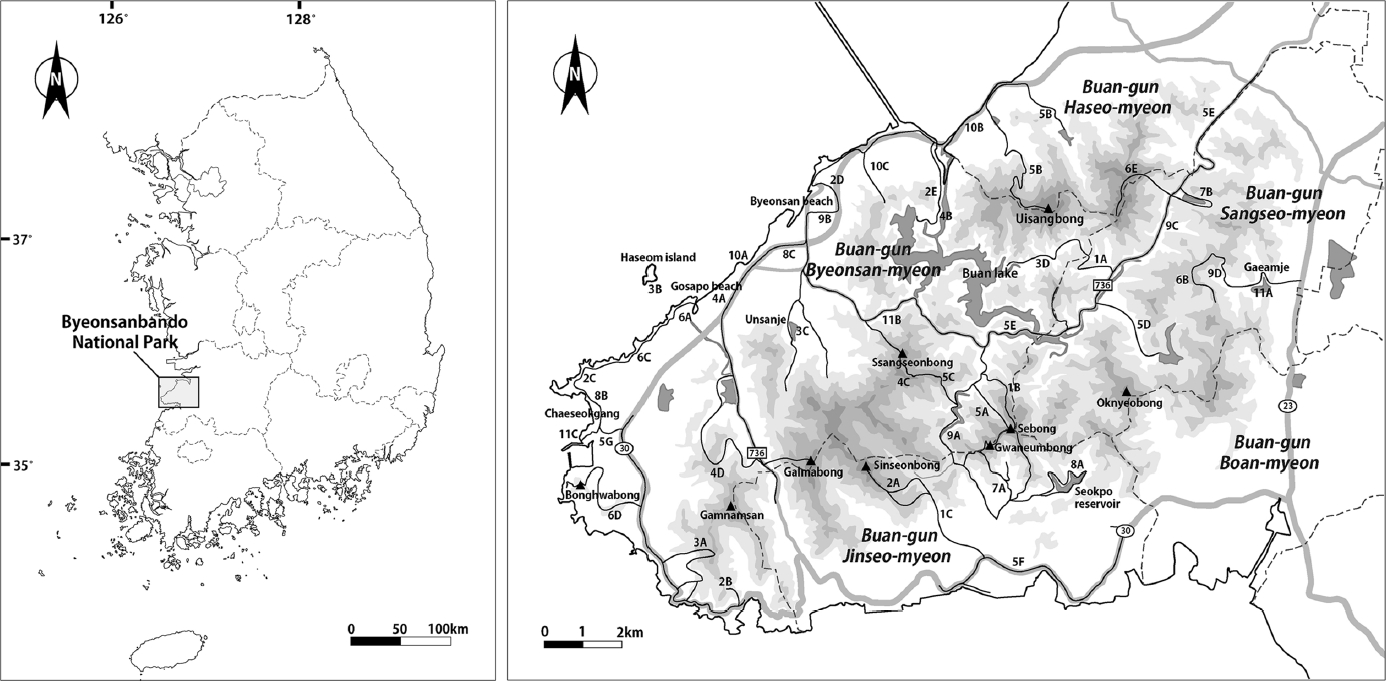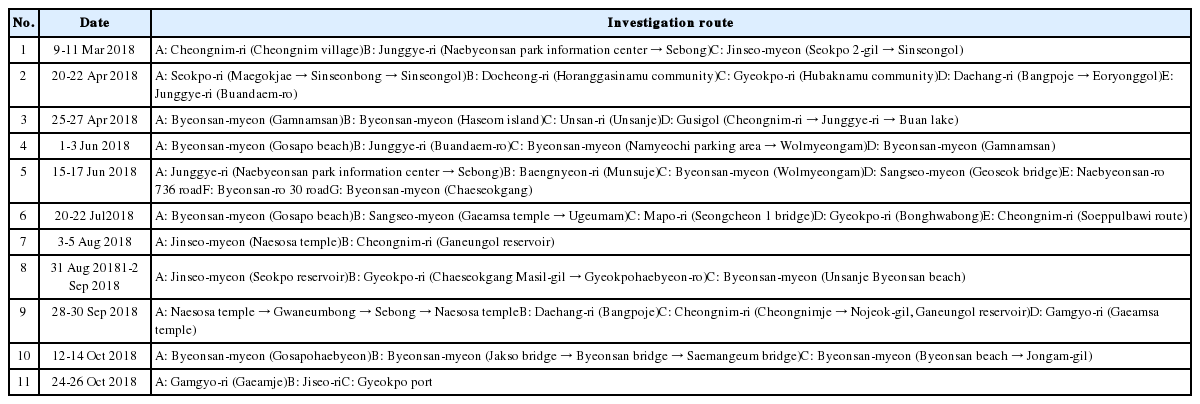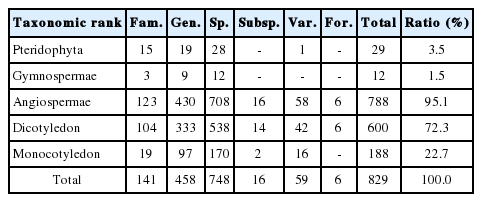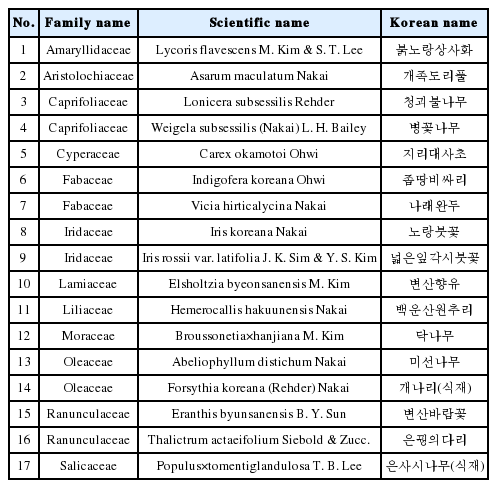변산반도국립공원의 관속식물상
Floristic study of Byeonsanbando National Park in Korea
Article information
Abstract
변산반도국립공원을 대상으로 2018년도 3월부터 10월까지 총 33일에 걸쳐 조사를 수행하였다. 증거 표본과 사진을 바탕으로 작성한 관속식물은 141과 458속 748종 16아종 59변종 6품종의 총 829분류군으로 기록되었다. 이 중 멸종위기식물은 노랑붓꽃, 삼백초(식재) 등 2분류군이 확인되었고, 희귀식물은 미선나무, 금털고사리 등 5분류군이 관찰되었다. 한반도 고유식물은 붉노랑상사화, 변산향유, 변산바람꽃 등 17분류군이 조사되었고, 식물구계학적 특정식물종은 III–V등급에 해당하는 52분류군이 확인되었다. 귀화식물은 총 79 분류군으로 생태계교란종은 돼지풀, 가시상추, 양미역취 등 7분류군이 확인되었다. 기후변화 취약종은 총 39 분류군이 분포하였고, 북방계 2분류군, 남방계 10분류군, 관심식물은 27분류군으로 확인되었다. 기존 조사에서는 확인되지 않았으나, 본 조사를 통해 새롭게 밝혀진 분류군은 186분류군이었다.
Trans Abstract
This study of vascular plants was conducted over a period of 33 days from March to October of 2018 in Byeonsanbando National Park, South Korea. Based on voucher specimens and photographs, 829 taxa in total were recorded, including 141 families, 458 genera, 748 species, 16 subspecies, 59 varieties, and 6 forma. Two endangered taxa were identified, Iris koreana Nakai and Saururus chinensis (Lour.) Baill. Five rare taxa were found, including Abeliophyllum distichum Nakai and Hypodematium glanduloso-pilosum (Tagawa) Ohwi. A total of 17 Korean endemic plants were investigated. Examples include Elsholtzia byeonsanensis M. Kim, Eranthis byunsanensis B. Y. Sun, and Lycoris flavescens M. Kim & S. T. Lee. Of floristic regional indicators (third to fifth degree), 52 taxa were identified. Naturalized plants were identified, which included 79 taxa, and 7 species of ecosystem disturbance plants, such as Ambrosia artemisiifolia L., Lactuca serriola L., and Solidago altissima L. were found. We recorded 39 taxa of the plants vulnerable to climate change.
국립공원은 자연생태계의 보고인 국가생물핵심보전지역으로 International Union for Conservation of Nature (IUCN)의 범주와 평가 기준에 따라 작성된 국가 적색목록 멸종우려종(threatened species)의 56.3%가 분포하는 동·식물의 핵심 서식지라고 할 수 있다(So et al., 2016). 이 중 19호로 지정된 변산반도국립공원은 산과 바다가 공존하는 반도형 공원으로 1988년도에 도립공원에서 국립공원으로 승격되었다. 전체 면적은 153.9 km2로 육상면적은 136.7 km2 (88.8%), 해상면적은 17.2 km2 (11.2%)를 차지하고 있다(Yuk and Park, 2019). 행정구역상으로는 전라북도 부안군 변산면, 보안면, 상서면, 진서면, 하서면에 걸쳐 있으며, 경·위도상 북위 34°21′–34°47′, 동경 126°37′–126°44′에 위치한다. 변산반도국립공원은 최고봉인 의상봉(508 m)을 중심으로 북동쪽으로 옥녀봉(354 m), 남동쪽에 삼예봉(354 m), 상여봉(398 m), 옥녀봉(432 m), 남쪽에 세봉(402 m), 남서쪽에 쌍선봉(459 m), 갑남산(408 m), 신선봉(488 m), 갈마봉(484 m) 등 해발 500 m 이내의 낮은 구릉성 산지가 위치한다. 중앙에는 부안호가 자리하고 있으며, 진서면 석포리에서 발원하는 직소천은 변산면 중계리, 부안호, 대항리를 거쳐 서해로 합류한다.
부안군의 최근 30년간 연평균 기온은 12.6°C, 연평균 최고기온과 최저기온은 각각 18.0°C와 8.0°C, 연평균 강수량은 1,250.4 mm로 기록되어 있다(Korea Meteorological Administration, 2019). 한반도 식물의 지리적 분포를 바탕으로 구분된 8개의 식물구계 중 남부아구에 속하며(Lee and Yim, 2002), 한반도 기후를 바탕으로 구분한 산림식물대 중 온대남부에 위치한다(Lim and Lee, 1999). 또한 변산 반도국립공원 내에는 도청리의 호랑가시나무 군락이 천연기념물 제122호, 격포리의 후박나무 군락이 제123호, 중계리의 꽝꽝나무 군락은 제124호, 미선나무 군락은 제370호로 각각 지정되어 있다(Cultural Heritage Administration, 2000).
변산반도국립공원의 식물상 연구는 Jeom (1990)이 119과 698분류군, Sun et al. (1995)이 117과 686분류군, Oh (1999)는 118과 721분류군을 보고하였으며, Yang et al. (2009)은 123과 721분류군에 대한 구체적 목록을 제시하였다. 한편 변산반도국립공원 내 특정지역을 대상으로 이루어진 소규모 식물상 연구에 따르면 소쩍골 주변 135분류군(Oh et al., 2008), 작은당 일대 105분류군(Oh and Beon, 2009), 하섬 일대 235분류군(Oh et al., 2011a), 노랑붓꽃과 붉노랑상사화 자생지에 관한 연구에서 147분류군(Oh et al., 2011b), 노랑붓꽃 자생지 연구에서 255분류군(Oh, 2017)의 분포를 제시한 바 있다.
본 조사는 국립공원공단에서 실시한 2018년도 제3기 국립공원 자연자원조사의 일환으로 수행되었으며, 변산반도 국립공원에 분포하는 식물자원에 대한 보다 면밀한 조사를 통하여 향후 변산반도국립공원 식물자원의 보전·관리방안을 수립하기 위한 기초자료로 활용하는 데 그 목적이 있다.
재료 및 방법
본 조사는 변산반도국립공원 전체를 대상으로 하였으며, 2018년 3월부터 10월까지 총 33일에 걸쳐 조사를 수행하였다(Fig. 1, Table 1). 결과의 정확성을 위해 현장에서 관찰한 모든 식물을 대상으로 검색형질에 유용한 꽃, 열매, 포자 등의 세부형질을 촬영하였으며(Nikon D5300 + AF-S 40 mm Macrolens, Tokyo, Japan; Nikon D5300 + AF 105 mm Macrolens), GPS 수신기(Nikon GP-1 & GP-1A)를 장착하여 각 식물에 대한 좌표를 획득하였다. 또한, 증거표본을 제작하여 국립공원연구원 표본실(NP)에 보관하였다. 분류군의 동정은 Lee (1996), Lee (2003), Kim and Kim (2011) 등의 도감을 이용하였고, 양치식물은 Korean Fern Society (2005), Park et al. (2008), Lee and Lee (2015), 벼과와 사초과는 Park et al. (2011), Cho et al. (2016)의 문헌을 참고하였으며, 몇몇 식물에 대해서는 최근 국내외 학술지에 발표된 논문을 참고하였다.
식물목록의 배열은 Engler의 분류체계를 기본으로 하되, 양치식물은 Christenhusz et al. (2011)의 분류체계를 따랐으며, 학명은 국가표준식물목록(Korea National Arboretum, 2017)을 따랐으나, 일부는 국가생물종목록집(National Institute of Biological Resources, 2019)을 참조하였다. 아울러, 멸종위기야생식물(Ministry of Environment, 2017), 희귀식물(National Institute of Biological Resources, 2012), 한반도 고유식물(Chung et al., 2017), 식물구계학적 특정식물(Kim et al., 2018), 귀화식물(Park, 2009; Lee et al., 2011) 및 생태계교란야생식물(Ministry of Environment, 2019), 기후 변화 취약 산림식물(Oh et al., 2010; Oh et al., 2013)과 유용 자원식물(Korea Forest Service, 2014) 등을 파악하였다.
결과 및 고찰
관속식물의 종조성
본 연구에서 확인된 변산반도국립공원 일대의 관속식물은 141과 458속 748종 16아종 59변종 6품종의 총 829분류군으로 조사되었다. 양치식물은 29분류군(3.5%), 나자식물은 12분류군(1.5%)이었으며, 피자식물의 쌍자엽식물은 600분류군(72.3%), 단자엽식물은 188분류군(22.7%)으로 확인되었다(Fig. 2A, Table 2). 이는 한반도 관속식물 4,498분류군(Korea National Arboretum, 2017)의 18.4%에 해당하였다. 과별 종구성에 의한 다양성은 국화과가 97분류군(11.7%)으로 가장 높은 비율을 나타냈으며, 벼과 82분류군(9.9%), 콩과 45분류군(5.4%), 장미과 39분류군(4.7%), 사초과 36분류군(4.3%), 백합과 24분류군(2.9%) 순으로 확인되었다(Fig. 2B). 조사된 목록 중 재배 또는 식재종으로 판단되는 식물은 개잎갈나무[Cedrus deodara (Roxb. ex D. Don) G. Don], 골담초 [Caragana sinica (Buc'hoz) Rehder], 두충(Eucommia ulmoides Oliv.), 모감주나무(Koelreuteria paniculata Laxm.), 사방오리 (Alnus firma Siebold & Zucc.), 삼나무[Cryptomeria japonica (Thunb. ex L. f.) D. Don], 앵도나무(Prunus tomentosa Thunb.), 옻나무[Toxicodendron vernicifluum (Stokes) F. A. Barkley], 중국단풍(Acer buergerianum Miq.), 측백나무[Platycladus orientalis (L.) Franco], 탱자나무[Poncirus trifoliatus (L.) Raf.], 회화나무(Sophora japonica L.) 등 89분류군으로 전체 분류군 중 10.7%를 차지하였으며, 자생종과 구분하기 위해 관속식물목록 (Appendix 1)의 국명 뒤에 별표(*)로 표시하였다.

The constitution rate of each plant group (A) and the constitution number of Family (B) in Byeonsanbando National Park.
멸종위기식물
멸종위기야생생물 II급(Ministry of Environment, 2017)에 해당하는 식물로는 노랑붓꽃(Iris koreana Nakai), 삼백초 [Saururus chinensis (Lour.) Baill.] (식재) 등 2분류군이 확인되었다(Table 3). 노랑붓꽃(Fig. 3A)은 전라북도 정읍시 입암면 노령 일대에서 최초 발견된 한반도 고유식물로서(Nakai, 1914), 변산반도 일대와 내장산 일대에 주로 분포하며 순창 조계산에는 극소수의 개체가 분포하고 있다. 조사지역 내 가장 큰 군락은 도청리(각수암골) 일대로서 수십 개체로 이루어진 소규모 집단이 계곡부를 따라 100여 곳 이상 확인되었으며, 감교리 일대 구릉지대에서는 숲 가장자리를 중심으로 수백 개체가 확인되었다. 대항리(어룡골), 중계리(구시골), 운산리(운산제) 인근에는 10여 개체씩 산발적으로 분포하고 있었다. 이번 조사를 통해 새롭게 확인된 대항리(어룡골) 자생지는 사람의 출입이 잦은 곳에 위치해 있어 훼손이 우려되며, 도청리와 감교리를 제외한 곳은 개체수가 감소할 가능성이 있어 별도의 관리방안이 필요할 것으로 판단된다. 삼백초는 새만금교 인근의 연못가에 식재되어 있었으며, 제주도의 일부 지역에만 자생하는 것으로 알려져 있으나 약용으로 전국 곳곳에서 재배가 이루어지고 있다.
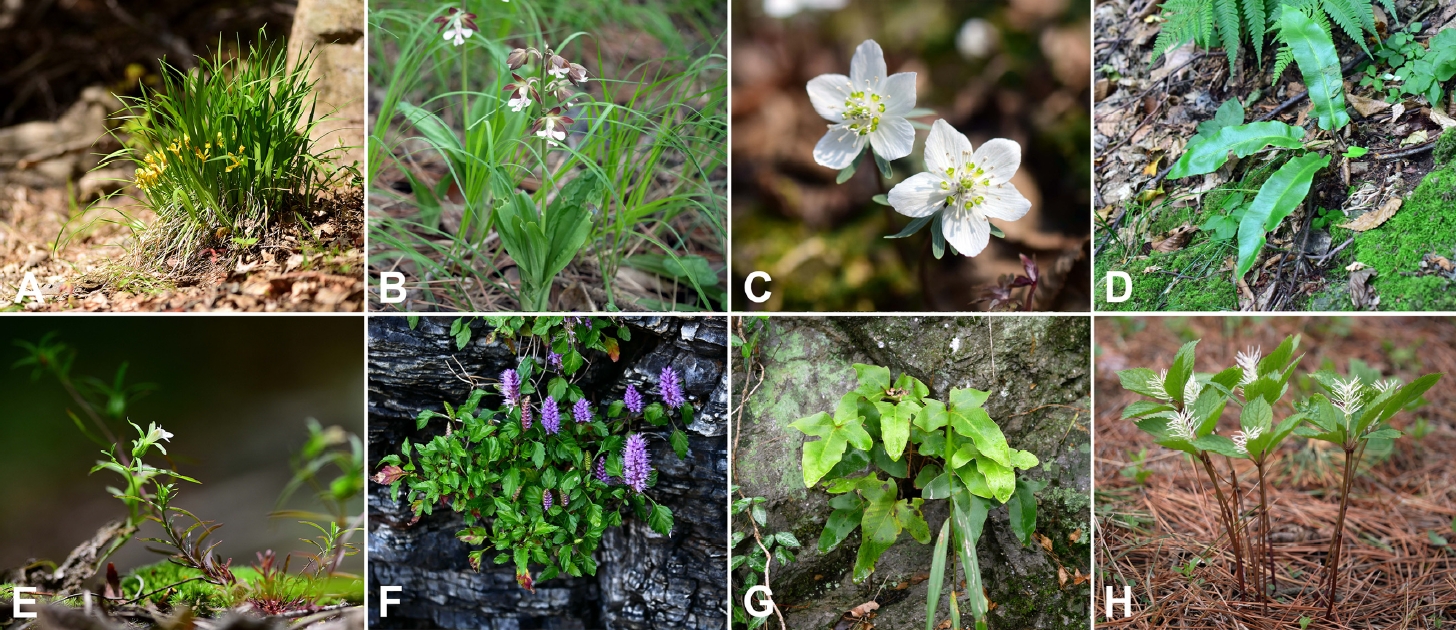
Some remarkable taxa in Byeonsanbando National Park (A and E photograph by N. Y. Kim). A. Iris koreana Nakai. B. Calanthe discolor Lindl. C. Eranthis byunsanensis B. Y. Sun. D. Asplenium scolopendrium L. E. Monochasma sheareri (S. Moore) Maxim. ex Franch. & Sav. F. Elsholtzia byeonsanensis M. Kim. G. Pyrrosia hastata (Houtt.) Ching. H. Chloranthus fortunei (A. Gray) Solms.
한편, 기존조사에서 확인되었던 멸종위기야생생물 II급 대흥란(Cymbidium macrorhizon Lindl.)과 매화마름(Ranunculus kadzusensis Makino)은 이번 조사에서는 확인되지 않았다. 이 중 대흥란은 2016년 공원구역 내 리기다 소나무 인공조림지 모니터링 중 분포를 확인하였으나 잎이 없고 토양의 유기물을 양분으로 살아가는 부생식물의 특성상 이번 조사에서는 확인하지 못하였다. 다만 탐방로가 없고 인위적 훼손위협이 낮은 지역이므로 지속적으로 개체의 확인 및 개체수 변화 등 모니터링을 수행할 필요가 있다. 매화마름은 2001년 전국자연환경조사를 통해 최초 확인되었으나(Sun and Baek, 2001) 자생지가 공원구역 밖에 위치하고 있어 지자체에서 변산해수욕장 관광지 조성에 따른 매화마름 자생지 파괴를 막기 위해 대체서식지를 조성하여 2015년 친환경개발 우수사례로 소개되었으나 불과 1년만인 2016년에 관리미흡에 대한 부정적 언론 보도가 있었다. 본 조사에서 4월, 6월, 10월 3회에 걸쳐 조사하였으나 개체를 확인할 수 없었다. 해당 대체서식지는 다른 지역의 매화마름 보호구역과는 달리 숲 가장자리에 위치하고 상층의 교목으로 인하여 그늘져 있으며 매화마름의 생활사에 가장 중요한 것으로 알려진 경작활동이 전무하다. 이로 인해 습지 내부에는 큰매자기, 좀개구리밥 등에 의해 완전히 피압되어 있었다. 법적보호종에 대한 대체서식지 조성 시, 해당 종의 생존에 필요한 생리생태 학적 특성, 집단의 크기 등을 면밀히 검토해야 할 것이며 인근 지역을 중심으로 신규 서식지를 발굴하여 종의 보전을 위한 노력을 지속해야 할 것이다.
희귀식물
환경부에서 지정한 적색자료집(National Institute of Biological Resources, 2012)에 따른 희귀식물은 총 5분류군이 확인되었다(Table 4). 위기종(endangered, EN)에 해당하는 삼백초(식재) 1분류군, 취약종(vulnerable, VU)은 노랑붓꽃, 미선나무(Abeliophyllum distichum Nakai), 향나무(Juniperus chinensis L.) (식재) 등 3분류군, 준위협(near threatened, NT)은 금털고사리[Hypodematium glanduloso-pilosum (Tagawa) Ohwi] 1분류군이 각각 확인되었다(Fig. 3A, Table 4). VU에 속하는 미선나무는 우리나라 고유속 고유종으로서 지난 2017년 멸종위기식물 II급에서 해제되었다. 알려진 자생지는 경기도(고양), 충북(괴산, 영동, 진천), 그리고 본 조사지역인 전북(부안)이다(Lee and Kil, 1991; Kim and Kim, 2008). 본 지역에 위치하는 미선나무 자생지는 남방한계선에 해당되므로 식물지리학적으로 매우 중요하다고 할 수 있다. 자생지 내 군락은 개화·결실상태가 양호하였으며, 천연기념물 제370호로 지정되어 별도관리가 이루어지고 있으므로 특별한 위협요인은 없을 것으로 추정되나, 자연적인 군락의 확대를 기대하기는 어려운 실정이다. 따라서 현재 군락의 쇠퇴를 대비하여 해당 유전자원을 종자 및 삽목 등의 형태로 확보하여 현지 외 보존이 필요하다고 판단된다.
한반도 고유식물
한반도 고유식물(Chung et al., 2017)은 개족도리풀(Asarum maculatum Nakai), 변산바람꽃(Eranthis byunsanensis B. Y. Sun), 변산향유(Elsholtzia byeonsanensis M. Kim), 붉노랑상사화(Lycoris flavescens M. Kim & S. T. Lee) 등 17분류군이 확인되었다(Table 5). 변산반도에서 최초로 발견되어 신종으로 발표된 대표적 고유식물로는 변산바람꽃(Sun et al., 1993)과 변산향유(Choi et al., 2012)가 있다. 변산바람꽃(Fig. 3C)은 청림리(청림마을), 중계리(봉래구곡), 내변산 탐방지원센터-세봉에서 대규모 군락이 확인되었으며, 변산반도국립공원의 깃대종으로 지정되어 보호되고 있다. 변산향유(Fig. 3F)는 최근 한반도 고유종 목록에 포함된 종으로(National Institute of Biological Resources, 2013), 봉화봉 인근의 바닷가 암벽에서 수십 개체를 확인하였다. 군락 내 개체 수와 생육상태는 양호한 것으로 판단되나 변산반도가 유일한 자생지이기 때문에 적극적인 보전계획 수립이 필요하다. 개족도리풀은 전북, 전남, 경남, 제주도 등에 주로 분포하는 남방계식물로서(Flora of Korea Editorial Committee, 2007; Leem and Oh, 2019), 변산반도 내소사지구, 도청리, 석포리, 중계리 등의 계곡부 주변 및 그늘진 숲 속에서 흔하게 관찰되었다. 붉노랑상사화는 변산반도국립공원의 청림리(청림마을), 중계리(봉래구곡)에서 대규모 군락이 확인되었으며, 본 지역 외에 경기(강화도), 충남(난지도), 전북(내장산, 모악산, 선운산), 전남(백양산, 불갑산), 경남(가야산)에도 생육하는 것으로 알려져 있다(Kim, 2004; Kim et al., 2017).
식물구계학적 특정식물종
식물구계학적 특정식물(Kim et al., 2018)은 총 161분류군으로 전체 소산식물의 19.4%에 해당하였다(Fig. 3, Table 6). 등급별로는 V등급에 노랑붓꽃, 미선나무, 삼백초(식재), 치자풀[Monochasma sheareri (S. Moore) Maxim. ex Franch. & Sav.), 털오갈피나무[Eleutherococcus divaricatus (Siebold & Zucc.) S. Y. Hu] 등 5분류군, IV등급에 대반하[Pinellia tripartita (Blume) Schott], 변산향유, 산복사나무[Prunus davidiana (Carrière) Franch.], 산외(Schizopepon bryoniifolius Maxim.) 등 9분류군, III등급에 금난초[Cephalanthera falcata (Thunb.) Blume], 내장고사리[Diplazium squamigerum (Mett.) C. Hope], 새우난초(Calanthe discolor Lindl.), 팥꽃나무(Daphne genkwa Siebold & Zucc.) 등 38분류군이 확인되었다. II등급은 34분류군으로 골고사리(Asplenium scolopendrium L.), 나도수정초[Monotropastrum humile (D. Don) H. Hara], 부채괴불이끼[Crepidomanes minutum (Blume) K. Iwats.] 등이 해당되며, I등급은 75분류군으로 나도밤나무(Meliosma myriantha Siebold & Zucc.), 송악[Hedera rhombea (Miq.) Siebold & Zucc. ex Bean], 좀딱취(Ainsliaea apiculata Sch. Bip.), 큰천남성[Arisaema ringens (Thunb.) Schott], 합다리나무[Meliosma pinnata (Roxb.) Maxim. var. oldhamii (Miq. ex Maxim.) Beusekom] 등 전반적으로 남방계 식물이 주로 확인되었다. 이번 조사에서 새롭게 확인된 식물구계학적 특정식물로는 갯그령[Leymus mollis (Trin.) Pilg.], 금털고사리, 모새달[Phacelurus latifolius (Steud.) Ohwi], 어리연꽃 [Nymphoides indica (L.) Kuntze], 치자풀, 통보리사초(Carex kobomugi Ohwi), 해국(Aster spathulifolius Maxim.) 등 47분류군이었다.

The list of the 5th to 3rd degree taxa of Korean floristic regional plants in Byeonsanbando National Park.
이 중 팥꽃나무는 서·남해안(황해도 이남에서부터 전남 진도, 해남, 청산도 등)에 분포하는 남방계식물로 해안가와 인접한 산기슭이나 숲 가장자리의 척박한 곳 또는 관목림과 어우러진 초지에 산발적으로 흩어져 생육하는 것으로 알려져 있다(Kim et al., 2018). 본 지역에서는 도청리 수락폭포 인근에서 소수의 개체를 확인하였으나 개체 수가 적고 관목림과 어우러져 관리가 잘 이루어지고 있지 않으므로, 추가적인 관리 방안이 필요할 것으로 보인다. 골고사리(Fig. 3D)는 ‘변산일엽’이라고도 불리며(Oh and Lee, 1992), 강원, 전남, 울릉도, 제주도에 분포하는 것으로 알려져 있다(Lee and Lee, 2015). 본 지역에서는 세봉삼거리 인근 계곡부에서 소수의 개체를 확인하였으며, 본 자생지에 대한 정밀조사가 이루어진다면 추가적으로 개체를 확인할 여지는 있으나, 개체수가 적어 향후 쇠퇴할 가능성이 높아 보인다. 청문에 따르면 과거 비교적 흔하게 분포하였으나 관상용으로 무분별하게 채취되었다고 하므로 현재 잔존하는 개체에 대한 별도의 보호와 더불어 지속적인 모니터링이 필요한 실정이다. 부채괴불이끼는 한반도 남부, 제주도, 속리산, 설악산, 금강산, 주왕산 등의 그늘지고 습한 바위나 나무에 착생하는 것으로 알려져 있으며(Korean Fern Society, 2005; Jang et al., 2019), 본 국립공원지역에서는 내변산탐방지원센터에서 세봉으로 가는 계곡부의 바위 곳곳에서 흔하게 확인할 수 있었다. 새우난초(Fig. 3B)는 갑남산 일대의 낙엽활엽수림에서 10여 개체, 운산제의 소나무림에서 70개체 가량이 확인되었다.
한편, V등급에 해당하는 치자풀(Fig. 3E)은 2000년대 이후 야생화 동호회원들을 통해 변산 일대에서 지속적으로 확인되었다. 조사기간인 2018년도에는 확인하지 못하였으나 2019년과 2020년에 도청리(각수암골)에 자생하는 것이 확인되었다. 치자풀은 열당과(Orobanchaceae)에 속하는 반기생성 식물로서, 최초 한국쌍자엽식물지(Park, 1974)에 기록되었으며, ‘Monochasma japonicum (Maxim.) Makino’를 정명으로 취급하고 ‘Monochasma sheareri var. japonicum Maxim.’을 이명으로 표기하였으나 해당 학명들은 현재 M. sheareri의 이명으로 처리되고 있다(Yonekura and Kajita, 2003; Tho et al., 2006). 그러나 Tho et al. (2006)은 본 종을 한국 미기록종으로 오인하여 발표하면서 ‘변산붙살이풀’로 신칭함으로서 국명의 혼란을 야기하였다. 본 식물의 현재까지 알려진 자생지는 변산반도를 비롯한 진도, 제주도에 국한되어 있으며, 특정한 환경에서만 출현하는 식물이므로 본 지역에 대한 지속적인 모니터링과 더불어 별도의 관리대책이 수립되어야 할 것이다.
귀화식물 및 생태계교란식물
조사지역에서 확인된 귀화식물(Lee et al., 2011)은 총 79 분류군이었으며, 이 중 국화과 식물이 30분류군(37.9%)으로 가장 높은 비율을 차지하였다(Table 7). 귀화율(naturalization index: 조사된 귀화식물의 종 수[79]/출현식물의 총 종 수[829]×100) (Numata, 1975)은 9.5%, 도시화지수(urbanization index: 조사된 귀화식물의 종 수[79]/남한의 귀화식물 총 종 수[321]×100) (Yim and Jeon, 1980)는 24.6%로 산출되어 우리나라 산림형 및 도시형 국립공원의 평균 귀화율과 평균 도시화지수(각각 6.8%, 15.3%)보다 높게 나타났으나(Yu, 2013), 해안형 국립공원의 평균 귀화율과 평균 도시화지수(각각 9.6%, 25.8%)와는 유사하였다(Yu, 2013). 출현빈도가 높은 곳은 해변로 및 도로 경계부와 주거지 및 농경지, 임도변, 저지대의 탐방로 주변으로 확인되었다(Fig. 4).

The distribution map of naturalized plants and ecosystem disturbance plants in Byeonsanbando National Park.
생태계교란야생식물(Ministry of Environment, 2019)에 해당되는 식물로는 가시상추(Lactuca serriola L.), 돼지풀(Ambrosia artemisiifolia L.), 미국쑥부쟁이[Symphyotrichum pilosum (Willd.) G. L. Nesom], 서양금혼초(Hypochaeris radicata L.), 양미역취(Solidago altissima L.), 애기수영(Rumex acetosella L.), 환삼덩굴[Humulus scandens (Lour.) Merr.] 등 7종이 확인되었다(Fig. 4, Table 7). 가시상추는 내소사 주차장 입구, 변산해수욕장, 새만금교 인근에 비교적 큰 군락을 이루고 있었고, 돼지풀은 가는골저수지, 청림제, 내변산로, 새만금교 등 저수지 및 도로변 곳곳에 불연속적으로 산생하고 있었다. 미국쑥부쟁이는 고사포해변, 서양금혼초는 채석강(격포리), 애기수영은 내변산로(중계리)에서 소규모 군락을 확인하였다. 양미역취는 밀원식물로 도입되어 전라북도 지역에 비교적 넓게 퍼져있는 생태계교란종으로 공원 구역 곳곳과 인접 지역인 변산 해수욕장 및 보안면 남포리 일대에서 확인되었으며, 특히 보안면(남포리)의 만석동 마을 주변에 큰 군락을 형성하고 있었다. 따라서 공원 지역을 비롯한 인접 지역의 확산 방지를 위하여 각각의 생육특성 및 생리학적 특성 파악을 통하여 종자산포 이전에 적극적인 방제 조치를 취해야 할 것이다.
유용식물
산림청의 자원식물 구분에 따르면(Korea Forest Service, 2014), 식용 503분류군, 약용 631분류군, 향료용 30분류군, 산업용 326분류군, 관상용 425분류군, 생태복원용 330분류군, 사료 및 퇴비용 331분류군으로 각각 파악되었으며, 중복된 항목을 제외하면 전체의 95%에 육박하는 784분류군이 이용 가능한 자원식물로 확인되었다. 또한, 54%에 해당하는 447분류군은 예로부터 사용해 왔던 민속식물(Chung et al., 2013)에 해당되는 것으로 나타났다.
기후변화 취약식물
기후변화 취약 산림식물(Oh et al., 2010; Oh et al., 2013)에 해당하는 식물은 39분류군으로 확인되었으며, 그중 목본식물은 35분류군(89.7%), 초본식물은 4분류군(10.3%)으로 나타났다(Table 8). 북방계 식물은 복자기(Acer triflorum Kom.), 전나무(Abies holophylla Maxim.) 2분류군(5.1%)만이 확인되었으며, 남방계 식물은 개족도리풀, 나도밤나무, 돈나무[Pittosporum tobira (Thunb.) W. T. Aiton], 변산바람꽃, 새비나무(Callicarpa mollis Siebold & Zucc.), 예덕나무[Mallotus japonicus (L. f.) Müll.Arg.] 등 10분류군(25.6%)이 확인되었다. 이 중 예덕나무, 나도밤나무와 새비나무는 조사구역 내 산림지역에서 흔하게 출현하였다. 관심식물로는 골고사리, 당단풍나무[Acer pseudosieboldianum (Pax) Kom.], 자귀나무(Albizia julibrissin Durazz.), 진달래(Rhododendron mucronulatum Turcz.), 철쭉(Rhododendron schlippenbachii Maxim.), 호랑가시나무(Ilex cornuta Lindl. & Paxton), 후박나무(Machilus thunbergii Siebold & Zucc.) 등 27분류군(69.2%)으로 나타났으며, 골고사리를 제외한 나머지 종들은 조사지역 내에서 매우 흔하게 관찰되었다. 도청리의 호랑가시나무군락과 격포리의 후박나무군락은 천연기념물 제122호와 제123호로 지정하여 보호하고 있다.
선행연구와의 비교
본 조사결과와 변산반도국립공원의 선행연구(Jeom, 1990; Sun et al., 1995; Oh, 1999; Sun and Baek, 2001; Im and Hong, 2006; Oh and Beon, 2009; Oh et al., 2013) 결과를 취합하여 비교·검토하였다. 취합된 목록을 국가표준식물 목록(Korea National Arboretum, 2017)과 국가생물종목록(National Institute of Biological Resources, 2019) 등에 준하여 정리한 결과 총 148과 571속 1,127종 5아종 129변종 20품종의 총 1,281분류군으로 집계되었다. 기존의 식물목록에 기록되지 않은 식물은 67과 151속 168종 3아종 14변종 1품종의 186분류군으로 확인되었으며, 이번 조사에서 새로이 확인된 분류군은 관속식물목록(Appendix 1)의 일련번호 앞에 ★로 표시하였다. 이 중 이번 조사에서 처음으로 확인된 적색자료집 식물에는 금털고사리, 나도수정초, 모새달, 새박, 새우난초 등이 관찰되었고, 고유식물로는 나래완두(Vicia hirticalycina Nakai), 넓은잎각시붓꽃(Iris rossii Baker var. latifolia J. K. Sim & Y. S. Kim), 변산향유 등이 분포하는 것을 확인하였다. 그 외에도 식물구계학적 특정식물인 갯까치수염(Lysimachia mauritiana Lam.), 노랑어리연꽃[Nymphoides peltata (S. G. Gmel.) Kuntze], 부채괴불이끼, 선메꽃[Calystegia dahurica (Herb.) Choisy], 세뿔석위[Pyrrosia hastata (Houtt.) Ching], 어리연꽃, 애기일엽초 [Lepisorus onoei (Franch. & Sav.) Ching], 옥녀꽃대 [Chloranthus fortunei (A. Gray) Solms], 치자풀, 큰옥매듭풀(Polygonum bellardii All.) 등 47분류군이 새로 발견되었다.
이번 조사에서 기존문헌에 기록되어있지만 확인하지 못한 식물은 92과 279속 385종 1아종 40변종 13품종의 439분류군으로 집계되었다. 이 중 멸종위기식물인 매화마름과 끈끈이귀개(Drosera peltata Thunb. var. nipponica (Masam.) Ohwi ex E. Walker)의 경우, 매화마름 자생지는 대항리 바닷가 인근의 논둑에서 발견(Sun and Baek, 2001)되었으나 현재도로 개발로 훼손된 상태이며, 변산해수욕장에 조성된 대체서식지에서도 식물체를 확인할 수 없었다. 수중 종자산포와 더불어 끊어진 줄기의 마디로 번식하는 매화마름의 생존전략으로 미루어 볼 때 주변 논 경작지를 상세히 조사한다면 추가적인 자생지를 발견할 가능성도 있을 것으로 판단된다. 끈끈이귀개도 기존의 자생지(Sun and Baek, 2001)에서는 확인할 수 없었으며, 생육지 환경의 변화와 주변의 개발로 인해 절멸된 것으로 판단된다. 그 외에도 환경부 적색자료집 식물 중 위기종(EN)에 해당하는 승마 [Actaea heracleifolia (Kom.) J. Compton], 취약종(VU)에 해당하는 산개나리[Forsythia saxatilis (Nakai) Nakai], 솔잎가래(Potamogeton pectinatus L.), 꼬마은난초(Cephalanthera subaphylla Miyabe & Kudô), 애기사철란[Goodyera repens (L.) R. Br.], 관심대상종(LC)에 해당하는 수정난풀(Monotropa uniflora L.), 개쓴풀[Swertia diluta var. tosaensis (Makino) H. Hara], 말나리(Lilium distichum Nakai ex Kamib.), 왕둥굴레 [Polygonatum robustum (Korsh.) Nakai], 흰제비란(Platanthera hologlottis Maxim.), NT에 해당하는 백작약[Paeonia japonica (Makino) Miyabe & Takeda], 채고추나물(Hypericum attenuatum Fisch. ex Choisy), 흑삼릉[Sparganium stoloniferum (Graebn.) Buch.-Ham. ex Juz.], 큰방울새란(Pogonia japonica Rchb. f.) 등이 기존 문헌 목록에 기록되어 있으나, 이번 조사에서는 확인하지 못하였다. 이 중 왕둥굴레의 경우 울릉도의 제한된 지역에서 기록이 확인된 종으로서 재확인이 필요할 것으로 판단된다(Jang, 2002). 실제 분포가 의심스러운 종으로는 강원도 이북, 태백산, 주왕산 등으로 기록되어 있는 노랑갈퀴(Vicia chosenensis Ohwi), 경기 및 강원 북부지역에 자생하는 산토끼고사리[Gymnocarpium jessoense (Koidz.) Koidz.], 북방계식물인 이삭바꽃(Aconitum kusnezoffii Rchb.), 갈매나무(Rhamnus davurica Pall.), 매자나무(Berberis koreana Palib.) 등이 이에 해당한다(Flora of Korea Editorial Committee 2007; Oh et al., 2016).
Acknowledgements
The authors deeply thank to Mr. N. Y. Kim for providing the information and photographs of plants. This work was supported by a grant from ‘Natural resource survey in Byeonsanbando National Park in 2018’ of Korea National Park Research Institute (no NPRI 2018-43).
Notes
Conflict of Interest
The authors declare that there are no conflicts of interest.
References
Appendices
Appendix 1.
The list of vascular plants of Byeonsanbando National Park including voucher specimens (★: newly recorded plant in this study, *: planted or cultivated plant)
kjpt-50-4-427-app.pdf
